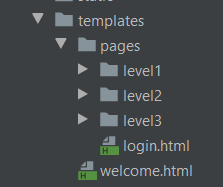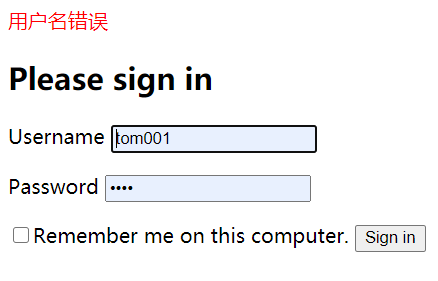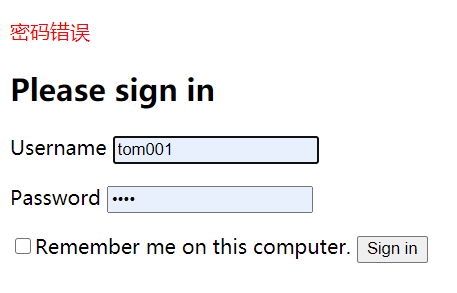SpringBoot--- Shiro(拦截,认证)
环境
IDEA :2020.1
SpringBoot: 2.3.3
Java : 8
版本依赖:
shiro-spring : 1.6.0
准备 :环境搭建
导入依赖
org.apache.shiro
shiro-spring
1.6.0
org.thymeleaf
thymeleaf-spring5
org.thymeleaf.extras
thymeleaf-extras-java8time
spring与Shiro 的整合包,模板引擎用的是 Thymeleaf。
编写 Controller 类
@Controller
public class HelloController {
@RequestMapping({"/","/index"})
public String index(Model model){
model.addAttribute("msg","Hello Shiro");
return "welcome";
}
@RequestMapping("/level1/{id}")
public String toLevel1(@PathVariable("id") int id){
return "pages/level1/" + id;
}
@RequestMapping("/level2/{id}")
public String toLevel2(@PathVariable("id") int id){
return "pages/level2/" + id;
}
@RequestMapping("/level3/{id}")
public String toLevel3(@PathVariable("id") int id){
return "pages/level3/" + id;
}
}
页面素材
采用之前整合 SpringSecurity 时候使用的HTML 页面。(提醒一下,注意导入支持 Thymeleaf 语法的命名空间)需要素材请联系我。
配置类
自定义 Realm,用于认证,授权(未完整)。
public class UserRealm extends AuthorizingRealm {
@Override
protected AuthorizationInfo doGetAuthorizationInfo(PrincipalCollection principalCollection) {
System.out.println("执行了授权===>doGetAuthorizationInfo");
return null;
}
@Override
protected AuthenticationInfo doGetAuthenticationInfo(AuthenticationToken authenticationToken) throws AuthenticationException {
System.out.println("执行了认证===>doGetAuthoricationInfo");
return null;
}
}
Shiro 配置类(基本框架)
@Configuration
public class ShiroConfig {
//3、ShiroFilterFactoryBean
@Bean
public ShiroFilterFactoryBean getfilterFactoryBean(
@Qualifier("securityManager") DefaultWebSecurityManager manager){
ShiroFilterFactoryBean bean = new ShiroFilterFactoryBean();
//配置SecurityManager
bean.setSecurityManager(manager);
return bean;
}
//2、DefaultWebSecurityManager
@Bean(name = "securityManager")
public DefaultWebSecurityManager getsecurityManager(@Qualifier("userRealm") UserRealm userRealm){
DefaultWebSecurityManager manager = new DefaultWebSecurityManager();
//关联 UserRealm
manager.setRealm(userRealm);
return manager;
}
//1、创建 realm 类,需要创建 UserRealm 继承 AuthorizingRealm 并重写方法
@Bean(name = "userRealm")
public UserRealm realm(){
return new UserRealm();
}
}
启动测试,程序是否正常。
1、拦截
拦截本质是通过过滤器,拦截器实现的。
Shiro 采用 ShiroFilterFactoryBean 配置 一个HashMap 来实现。在配置之前我们需要了解配置的含义。
权限过滤器及配置释义
anon:例子/admins/*=anon 没有参数,表示可以匿名使用。*
authc:例如/admins/user/*=authc表示*需要认证(登录)*才能使用,没有参数*
roles(角色):例子/admins/user/=roles[admin],参数可以写多个,多个时必须加上引号,并且参数之间用逗号分割,当有多个参数时,例如admins/user/=roles["admin,guest"],每个参数通过才算通过,相当于hasAllRoles()方法。
perms(权限):例子/admins/user/=perms[user:add:*],参数可以写多个,多个时必须加上引号,并且参数之间用逗号分割,例如/admins/user/=perms["user:add:,user:modify:"],当有多个参数时必须每个参数都通过才通过,想当于isPermitedAll()方法。
rest:例子/admins/user/=rest[user],根据请求的方法,相当于/admins/user/=perms[user:method] ,其中method为post,get,delete等。
port:例子/admins/user/**=port[8081],当请求的url的端口不是8081是跳转到schemal://serverName:8081?queryString,其中schmal是协议http或https等,serverName是你访问的host,8081是url配置里port的端口,queryString
是你访问的url里的?后面的参数。
authcBasic:例如/admins/user/**=authcBasic没有参数表示httpBasic认证
ssl:例子/admins/user/**=ssl没有参数,表示安全的url请求,协议为https
user:例如/admins/user/**=user没有参数表示必须存在用户(使用了cookies session保存了用户),当登入操作时不做检查
配置过滤并测试
在 ShiroFilterFactoryBean 的 setFilterChainDefinitionMap 配置过滤规则。同时配置登录页面,未登录访问相关 authc 级别页面将跳转到登录页面。
//3、ShiroFilterFactoryBean
@Bean
public ShiroFilterFactoryBean getfilterFactoryBean(
@Qualifier("securityManager") DefaultWebSecurityManager manager){
ShiroFilterFactoryBean bean = new ShiroFilterFactoryBean();
//配置SecurityManager
bean.setSecurityManager(manager);
Map filterMap = new LinkedHashMap<>();
filterMap.put("/level*/**","authc");
//配置过滤规则
bean.setFilterChainDefinitionMap(filterMap);
return bean;
}
暂时不配置登录页面,这是下一个章节的内容,启动访问,并点击访问需要登录的资源。
Shiro 竟然还 “贴心” 地准备用JSP ,别说了,看见 JSP就头疼,学校里还教了这个.....(这里多说一句,别死磕JSP了,后端的学学JSTL表达式就行。)
2、认证
Shiro 配置类
结合前面的配置,在 Shiro 配置类 的 ShiroFilterFactoryBean 配置登录的url
//配置登录url
bean.setLoginUrl("/log/toLogin");
配置 Controller 类
@Controller
@RequestMapping("/log")
public class LogController {
@RequestMapping("/toLogin")
public String toLogin(){
return "/pages/login";
}
@RequestMapping("/doLogin")
public String login(String username , String password , Model model){
//获取当前用户
Subject subject = SecurityUtils.getSubject();
//生成令牌
UsernamePasswordToken token = new UsernamePasswordToken(username , password);
try{
//用令牌尝试登录,失败会抛出异常
subject.login(token);
//成功则返回主页
return "welcome";
}catch ( UnknownAccountException e){ //捕捉抛出用户名错误
model.addAttribute("msg","用户名错误");
return "/pages/login";
}catch (IncorrectCredentialsException e){//捕捉抛出密码错误
model.addAttribute("msg","密码错误");
return "/pages/login";
}
}
}
这里说一下, url 为 /doLogin 的方法,这里用到了一个 Shiro 的核心对象 Subject ,表示当前用户,后面将用于登录。
这里非常神奇,不需要任何传参,直接通过 SecurityUtils.getSubject() 获取 Subject 。这一点有点难以理解。不过确实是可以获取的,可以理解为是 Shiro 为我们将这些联系了起来。

生成令牌,我们回到 UserRealm 类 的 doGetAuthenticationInfo 方法。
@Override
protected AuthenticationInfo doGetAuthenticationInfo(
AuthenticationToken authenticationToken) throws AuthenticationException {
有一个参数 AuthenticationToken ,它的类型是 认证令牌,查看源码,发现是一个接口。
那就来看他的实现类。
最后一个是用户名密码令牌,查看源码,它的构造方法,可以用来生成一个用于身份认证的令牌。
/**
* Constructs a new UsernamePasswordToken encapsulating the username and password submitted
* during an authentication attempt, with a null {@link #getHost() host} and a
* rememberMe default of false.
*
* @param username the username submitted for authentication
* @param password the password character array submitted for authentication
*/
public UsernamePasswordToken(final String username, final char[] password) {
this(username, password, false, null);
}
回到我们的登录方法,我们可以用页面传递过来的username ,password 生成一个 UsernamePasswordToken 令牌。
之后就是用令牌登录,失败就捕获一些异常,返回一些提示信息到页面。
这里还剩下一个问题,我们作为开发者怎么让 Shiro 知道正确的用户名和密码,这里回到了 UserRealm 类 的 doGetAuthenticationInfo 方法进行配置,这里采用明文用户名和密码配置,后面整合 Mybatis 将结合数据库获取。
@Override
protected AuthenticationInfo doGetAuthenticationInfo(AuthenticationToken authenticationToken) throws AuthenticationException {
System.out.println("执行了认证===>doGetAuthoricationInfo");
//明文配置用户名和密码
String username = "tom001";
String password = "1234";
//获取令牌
UsernamePasswordToken userToken =(UsernamePasswordToken) authenticationToken;
//验证用户名
if (!userToken.getUsername().equals(username)){
return null;
}
//验证密码交由 Shiro 完成
return new SimpleAuthenticationInfo(username,password,"");
}
这里的获取令牌,与之前的生成令牌呼应了。具体对象传递是由 Shiro 完成的。
验证用户名不通过,返回 null 将会由之前登录方法捕获到异常,再做相应处理。
密码不由我们进行处理,可以说是非常安全了。
注意返回值,需要的只是一个接口,我们可以返回它的实现类。
图中两个都是可以使用的,都可以用于认证。
它的构造函数,查看源码
/**
* Constructor that takes in a single 'primary' principal of the account and its corresponding credentials,
* associated with the specified realm.
*
* This is a convenience constructor and will construct a {@link PrincipalCollection PrincipalCollection} based
* on the {@code principal} and {@code realmName} argument.
*
* @param principal the 'primary' principal associated with the specified realm.
* @param credentials the credentials that verify the given principal.
* @param realmName the realm from where the principal and credentials were acquired.
*/
public SimpleAuthenticationInfo(Object principal, Object credentials, String realmName) {
this.principals = new SimplePrincipalCollection(principal, realmName);
this.credentials = credentials;
}
其中,principal,credentials ,可以通俗地理解为 用户名,密码,最常见的组合也是用户名和密码。
测试
如有疑问,还可以查看官网给出的十分钟快速入门。https://shiro.apache.org/10-minute-tutorial.html





